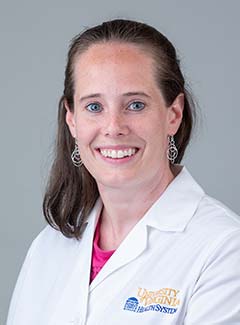
At a Glance
Title: Assistant Professor
Residency: Pediatrics and Child Neurology, Duke University
Medical Degree: Brody School of Medicine at East Carolina University
Kathryn Xixis, MD, is a child neurologist with a clinical interest in neurofibromatosis. The winner of numerous awards for her work as an educator and mentor, she joins UVA as the program director of the child neurology residency program.
You spent your last four years as a faculty member at East Tennessee State University’s Quillen College of Medicine. What did you learn from that experience?
I grew up in Greensboro, North Carolina and went to East Carolina University for medical school. I thought it would be fulfilling to begin my career by working in a smaller setting. As it turned out, I was the only pediatric neurologist in 30 counties, not an uncommon situation in rural areas. I found that in these situations, you naturally assume a variety of roles. I did all the inpatient and outpatient work and read all the EEGs.
I think the experience made me a better clinician. I learned a lot about taking care of a wide variety of patients. And it certainly helped me become a better time manager.
How did the limited medical resources in largely rural areas affect the health of the patients you saw?
The long distances patients needed to travel made it difficult for parents of my patients to connect to the appropriate subspecialists, which in practical terms meant that the patients I saw tended to be more complicated. As a result, I ended up doing a lot of catch-up and polishing to their treatment plans.
At the same time, the lack of subspecialists can make it more difficult to provide appropriate care. In these situations, you lack many of the subspecialty resources that neurologists routinely interface with in complex patient cases.
How has this experience shaped your goals at UVA?
One of the conditions I became interested in while at East Tennessee is neurofibromatosis, a genetic disorder that causes tumors to form on nerve tissue anywhere in your body. Although the tumors are often benign, complications can include developmental delay, learning problems, headaches, tumors and pain. Because these tumors can appear anywhere, it often requires a team of multidisciplinary specialists to treat the disease.
Now that I am at UVA, I am working with other subspecialists to create a multidisciplinary neurofibromatosis clinic. In addition to caring for children with neurofibromatosis, we want to ensure a smooth multidisciplinary transition of care once patients become adults.
As your UVA practice grows, how do you plan to interact with referring physicians?
Having spent time in a medically under-served area, I can understand providers’ concerns with getting patients in for subspecialty care. Once we receive a referral, we examine it to develop a care plan for the patient. We then do our best to schedule an appointment with the most appropriate provider in the most timely way.
Once I see a patient, I will send them a copy of my note. If they are on Epic, referring physicians can send us their questions and concerns directly. Otherwise, we can communicate by telephone.
You received the Caduceus Award from the Quillen College of Medicine twice as well as the national Alpha Omega Alpha Volunteer Clinical Faculty Award for your teaching and mentoring. When did you decide to make education a critical component of your career?
At first, I really didn’t consciously understand how much education meant to me, but during an end-of-year review with my chair at East Tennessee, I asked whether it would be possible for me, as a neurologist, to be program director of the pediatrics residency program. I think I was telling myself that I was sufficiently interested in education to play a more formal role.
East Tennessee has a smaller general pediatrics residency program, and I began by offering a pediatric neurology elective rotation for pediatric residents. The longer I was there, the more I branched out. I gave formal lectures for the pediatric residents as well as for the family medicine residents. I also started working with medical students. Among other initiatives, I provided my insights as a clinical neurologist to the material they covered in their neuroscience course.
I also found that it was important to me to offer practical, real-world advice to students and trainees. I want to help young clinicians not only be better physicians but also better navigate their lives as physicians.
At UVA, you are the program director of the child neurology residency program. What is your vision for the program?
This is a successful, well-established child neurology program. We have a strong core curriculum and offer a variety of electives that enable residents to explore a range of general and specialty options. I am interested in making sure that residents participate in key elective experiences to gain the auxiliary skills required for success in all types of child neurology practices. They should feel confident that they have the skills to go on to become a subspecialist in child neurology at a large academic institution or a generalist in child neurology in a community setting.
How have your clinical and educational initiatives been received at UVA?
Everybody at UVA has been very receptive. As long as what you propose elevates the clinical care and education we offer, people here are ready to support you. And because the culture is already collaborative, people welcome multidisciplinary efforts like the neurofibromatosis clinic.
You arrived in Charlottesville in May. How has the transition gone?
My husband, Terry, and I really enjoy Charlottesville — though we found that moving with a 17-month-old is a lot harder than moving without one! We are happy to be here. It’s clearly a great place for families.
To refer a patient to UVA Health, call UVA Physician Direct at 800.552.3723.